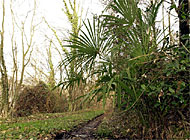
Palm trees go wild in Ticino

Palm trees and other exotic species have become so common in the forests of Switzerland's southern canton of Ticino they must now be considered as "native".
Scientists at the Federal Institute of Technology in Zurich say mild winters over the past 30 years have enabled foreign trees planted in public parks to gain a foothold in the wild.
Among the species now growing in Ticino are the bay laurel, camphor tree laurel, cherry laurel, thorny silverberry and Chinese fan palm. All are evergreens known until recently only in gardens and parks.
The exotic plants were brought to Ticino, Switzerland’s only region on the warmer southern side of Alps, in the 17th and 18th centuries. Foresters first observed exotic specimens in the wild about 50 years ago.
But it was only a little over 10 years ago that whole sections of forest in the southern part of the canton were found to be dominated by the plants.
Gian-Reto Walther, who carried out the research, says the exotic evergreens are particularly sensitive to winter temperatures. They find it hard to survive where temperatures regularly fall below minus 10 degrees.
He said an analysis of climate data showed that while temperatures in the first half of the 20th century dropped that low on average every seven years, they only reached that level every 20 years in the second half.
Walther told swissinfo there was little cause for concern for the time being, although the new species were certain to gain ground on the indigenous ones in the future.
“At present the situation in the forest does not look alarming, because the diversity of the species has increased. There are a lot of indigenous species, and now also a number of these exotic species that co-exist in the forest,” he explained.
“In the mid-term we think the number of these evergreen species will increase in density and form a new type of forest.”
Walther says the ecosystem in Ticino now needs to be studied to see if changes in the composition of the forest are affecting the animals that depend on the plants.
But Ticino’s most famous fruit, the chestnut, is not yet in any danger of being driven out by the date or the coconut.
by Malcolm Shearmur

In compliance with the JTI standards
More: SWI swissinfo.ch certified by the Journalism Trust Initiative


























You can find an overview of ongoing debates with our journalists here . Please join us!
If you want to start a conversation about a topic raised in this article or want to report factual errors, email us at english@swissinfo.ch.